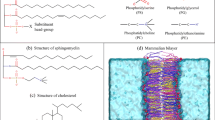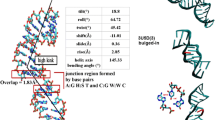Abstract
The secondary structures and the shapes of long-chain polyalanine (PA) molecules were investigated by all-atom molecular dynamics simulations using a modified Amber force field. Homopolymers of polyaminoacids such as PA are convenient models to study the mechanism of protein folding. It was found that the conformational structures of PA peptides are highly sensitive to the chain length. In the absence of solvent, straight α-helices dominate in short (n ∼ 20) peptides at room temperature. A shape transition occurs at a chain length n of 40–45; the compact helix-turn-helix structure (the double-leg hairpin) becomes favored over a straight α-helix. For n = 60, double-leg and the triple-leg hairpins are the only structures present in PA molecules. An exploration of a chain organization in a cubic cavity revealed a clear predisposition of PA molecules for additional breaks in α-helices and the formation of multifolded hairpins. Furthermore, under confinement the hairpin structure becomes much looser, the antiparallel positions of helical stems are disturbed, and a sizeable proportion of the helical stems are transformed from α-helices into 310-helices.










Similar content being viewed by others
References
Smith AV, Hall CK (2001) α-Helix formation: discontinuous molecular dynamics on an intermediate-resolution protein model. Proteins 44:344–360
Shental-Bechor D, Kirca S, Ben-Tal N, Haliloglu T (2005) Monte Carlo studies of folding, dynamics, and stability in α-helices. Biophys J 88:2391–2402
Mortenson PN, Evans DA, Wales DJ (2002) Energy landscapes of model polyalanines. J Chem Phys 117:1363–1377
Nymeyer H, Garcia AE (2003) Simulation of the folding equilibrium of α-helical peptides: a comparison of the generalized born approximation with explicit solvent. Proc Natl Acad Sci USA 100:13934–13939
Garcia AE (2004) Characterization of non-alpha helical conformations in Ala-peptides. Polymer 45:669–676
Sorin EJ, Pande VS (2005) Exploring the helix-coil transition via all-atom equilibrium ensemble simulations. Biophys J 88:2472–2493
Levy Y, Jortner J, Becker OM (2001) Solvent effects on the energy landscapes and folding kinetics of polyalanine. Proc Natl Acad Sci USA 98:2188–2193
Soto P, Baumketner A, Shea J-E (2006) Aggregation of polyalanine in a hydrophobic environment. J Chem Phys 124:134904–134910
Palencar P, Bleha T (2010) Folding of polyalanine into helical hairpins. Macromol Theory Simul 19:488–495
Khutorsky V (2003) Alpha-hairpin stability and folding of transmembrane segments. Biochem Biophys Res Commun 301:31–34
Zhou HX (2008) Protein folding in confined and crowded environments. Arch Biochem Biophys 469:76–82
Cheung MS, Klimov D, Thirumalai D (2005) Molecular crowding enhances native state stability and refolding rates of globular proteins. Proc Natl Acad Sci USA 102:4753–4758
Sikorski A, Romiszowski P (2007) Computer simulation of polypeptides in a confinement. J Mol Model 13:327–333
Lucent D, Vishal V, Pande VS (2007) Protein folding under confinement: a role for solvent. Proc Natl Acad Sci USA 104:10430–10434
Krieger E, Darden T, Nabuurs S, Finkelstein A, Vriend G (2004) Making optimal use of empirical energy functions: force-field parameterization in crystal space. Proteins 57:678–683
Kabsch W, Sander C (1983) Dictionary of protein secondary structure: pattern recognition of hydrogen-bonded and geometrical features. Biopolymers 22:2577–2637
Cifra P, Bleha T (2010) Shape transition of semi-flexible macromolecules confined in channel and cavity. Eur Phys J E 32:273–279
Zagrovic B, Jayachandran G, Millett IS, Doniach S, Pande VS (2005) How large is α-helix? Studies of the radii of gyration of helical peptides by small-angle X-ray scattering and molecular dynamics. J Mol Biol 353:232–241
Zhang W, Lei H, Chowdhury S, Duan Y (2004) Fs-21 peptides can form both single helix and helix-turn-helix. J Phys Chem B 108:7479–7489
Acknowledgments
This work was supported by the Science and Technology Assistance Agency under contract nos. APVV-0079-07 and No. APVV-0607-07, and by VEGA grants 2/6116/26 and 2/6014/26. The work also benefited from the Centers of Excellence Program of the Slovak Academy of Sciences (COMCHEM).
Author information
Authors and Affiliations
Corresponding author
Rights and permissions
About this article
Cite this article
Palenčár, P., Bleha, T. Molecular dynamics simulations of the folding of poly(alanine) peptides. J Mol Model 17, 2367–2374 (2011). https://doi.org/10.1007/s00894-011-0997-4
Received:
Accepted:
Published:
Issue Date:
DOI: https://doi.org/10.1007/s00894-011-0997-4




